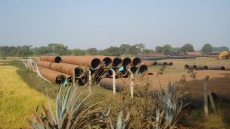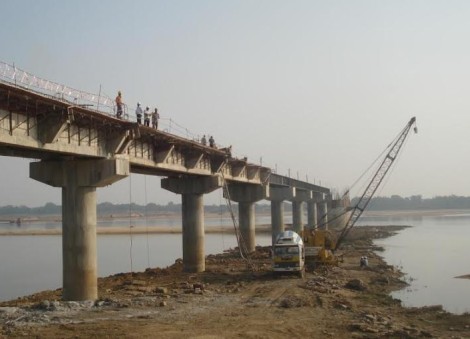At first look, Janjgir-Champa seems just another district in the western part of Chattisgarh. But it holds the distinction of being the district with the highest proposed thermal power capacity addition in the whole country. Its neighbour, the Raigadh district follows a close second. Between the two, at least 55,000 Megawatts (MW) of coal-based thermal power generation is in the pipeline. This massive spree of thermal power plant construction has recently been in the news, particularly in the context of the coal allocation scam.
However, the allocation of another natural resource equally critical for coal based thermal power plants seems to have escaped equal attention. This resource is water, which is needed in massive quantities for such plants, and developments in Janjgir-Champa district illustrate that the irregularities and issues related to the allocation of water are no less than those present in coal allocation.
Water diversions for thermal power plants
These districts are blessed with ample water resources, given the magnificent Mahanadi River and its tributaries Hasdeo, Mand and Kelo flowing through them as well as good rainfall. It is not surprising then that Janjgir-Champa, with 66 per cent of its gross cropped area being irrigated, is the district with the highest percentage of its land under irrigation in the state. Now, the large numbers of proposed thermal power plants are threatening to take away not only considerable parts of the land, but also huge quantities of water, with huge potential impacts on the lives and livelihoods of the population in a variety of ways.
Just one of the arrangements to deliver water to the thermal power plants illustrates the serious issues involved. The Government of Chattisgarh is planning a series of five bumper-to-bumper barrages on the Mahanadi River from the village of Sheorinarayan to the village of Kalma. The other three sites are at villages of Basantpur, Mironi and Saradih, all of them in the Janjgir-Champa district. This will effectively convert a stretch of about 50 km of the river into a cascade of reservoirs.
The total storage capacity of these five barrages taken together is about 245 million cubic meters (MCM), and they will supply close to 920 MCM water to 30 thermal power plants (and a few other industries). That much water is enough to irrigate about 450,000 acres of agricultural land.

Since the power plants are going to pay for the barrages, it is clear that no water will be provided for any other use until their own needs are met. (Pic: Pipes stacked to take water to the power plants)
Serious Impact
The combined impact of all these projects will be quite significant. However, no environmental impact assessment of any kind has been carried out for them. It is claimed that as these are barrages, there will be no submergence, which is true to some extent.
A barrage, by definition, is a structure that retains water only to the height of the river channel. So it does not submerge any new areas. However, this statement misses one crucial fact. In the Mahanadi basin in this area, when the river flow declines after the monsoon, large parts of the river bed open up. People on the banks of the river then cultivate the river bed, the sand beds, growing large number of crops like water melons, musk melons, cucumber, vegetables, pumpkins etc. This is a very important source of livelihood and incomes, especially as many of those engaged in such cultivation are landless families.
Local activists estimate that close to 5000-6000 families may be dependent on the riverbed cultivation in this stretch of 50 km. The barrages will permanently inundate the river bed for this stretch, effectively ending the livelihoods of these people. This will impact not only the Mahanadi itself, but also river-bed cultivation in several tributaries and nallahs that meet the Mahanadi in this stretch.
Similarly, the impounding of water will effectively convert the flowing river to a series of ponds, and this is likely to have a big impact on fish in the river - again, an important means of nutrition and income generation for the local communities.
The project documents list many other 'benefits' of these barrages, including ground-water recharge, lift irrigation and increased connectivity among villages across the river facilitated by roads on top of the barrage. However, except for connectivity, questions may be raised about the other listed benefits. For one, it is not clear - nor studied scientifically - how much seepage would occur and what the amount of groundwater additionally available would be, and for how much land.
Secondly, there is no clarity that lift irrigation by farmers will get priority, especially in the lean season, when there may not be enough water for both thermal power plants and the lift irrigation. This is because the main and primary purpose of the projects is supplying water to the thermal power plants. As the project reports mention, "water can be stored for ... nistari, drinking and ground water recharging and mainly to supply water to power plants ..."
What the relative priorities attached to irrigation and water supply for thermal power plants will actually be is also clear from the fact that the costs of the barrages are going to borne by the thermal power plants in proportion to the water they will receive. Since the power plants are going to pay for the barrages, it is clear that no water will be provided for any other use until their own needs are met. This means that the reliability of lift irrigation in the post monsoon season would be doubtful.
In fact, there are no studies to quantify the claimed benefits of these projects (and the uncertainties in them). Neither are there any attempts to assess or study the negative impacts. Because of this, the true costs and benefits of the projects remain a matter of faith and assertion.
No Impact Assessment
Normally, one would expect some of the questions raised above to be addressed under the Environmental Impact Assessment (EIA) process. However, none of these projects have had an EIA undertaken.
First, there was an attempt to see if the EIA Notification of 2006 is applicable to these projects. This is possible due to a loophole in the Notification itself a deliberate or an accidental omission in the specification of projects that need environmental clearance (EC), due to which even large dams meant for drinking or industrial water supply are escaping the EC process. The state requested the Ministry of Environment and Forests (MoEF) to clarify the applicability of the Notification to these projects.
The MoEF did not respond, but the State Expert Appraisal Committee (SEAC) and the State Environment Impact Assessment Authority (SEIAA) took a decision that the projects do need an EC at the state level. However, whether they need a full EIA (for the so called B1 Category projects) or just an EC is yet to be decided.
To decide that, the SEAC asked the projects to submit information about some basic aspects such as "water planning of the project, justifying the minimum flow on downstream according to CWC guidelines" and "impact on flora and fauna in the river beds for the proposed project area". To these questions, all five projects gave the same standard reply. Responding to the first question, they only listed the thermal power project and the water to be supplied to these, and stated that "Water shall be made available for the projects constructed in the downstream." On flora-fauna in the region, all the projects responded that there was no wildlife sanctuary or protected area within 10 km of the project.
Meanwhile, the SEAC also realised that the five projects are quite close to each other. Hence, in December 2011, they asked the Government to present a comprehensive report of the impact of these five projects taken together, or in other words, a cumulative impact assessment. Interestingly, the SEAC asked for the impact on flora and fauna on the river bed.
Today, after almost two years, this comprehensive report has not been submitted. Meanwhile, construction and other work has begun on some of these barrages, and continues with impunity. Taking cognisance of this, the SEAC, in its 111th meeting held on 7 September 2013, ruled in relation to one of the barrages, namely Saradih, that:
"... the report submitted by the project proponent is not satisfactory. It is also informed that the work of excavation and laying foundation is 50 per cent and 35 per cent completed respectively and the project is likely to be completed by June 2014. ... Committee also decided that since documents submitted by the project proponent vide letter dated 14/06/2013 reveals that construction works of the project has already been started, which is violation of the provision of EIA Notification, 2006 therefore legal action against the project proponent should be initiated under the provisions of Environment (Protection) Act, 1986."
However, when I visited the Saradih barrage site last month, the construction work was still going on.

Intake well and pipeline carriage-way for one of the power plants under construction.
Conclusion
Here is a situation, therefore, where massive intervention in the form of construction of five back to back barrages in the Mahanadi River is underway. This will result in the creation of a virtually 50 km long reservoir, destroying the river bed agriculture on which several thousand people depend, and will seriously impact the fisheries. On the other hand, the benefits to the local people are uncertain and not based on any studies, but mere assertions.
The only benefits that are well-defined and certain are the water to be supplied to the thermal power stations. The projects have not undergone any impact assessment, nor have they got an EC. Yet, construction continues. All this is testimony to the financial - and political - power of those behind these thermal power projects. Unfortunately, such blatant diversion of water for industry, especially power plants, is not unique to these five barrages. Such cases are found in many other parts of the country.
Water diversion may the next scam on the horizon.
























